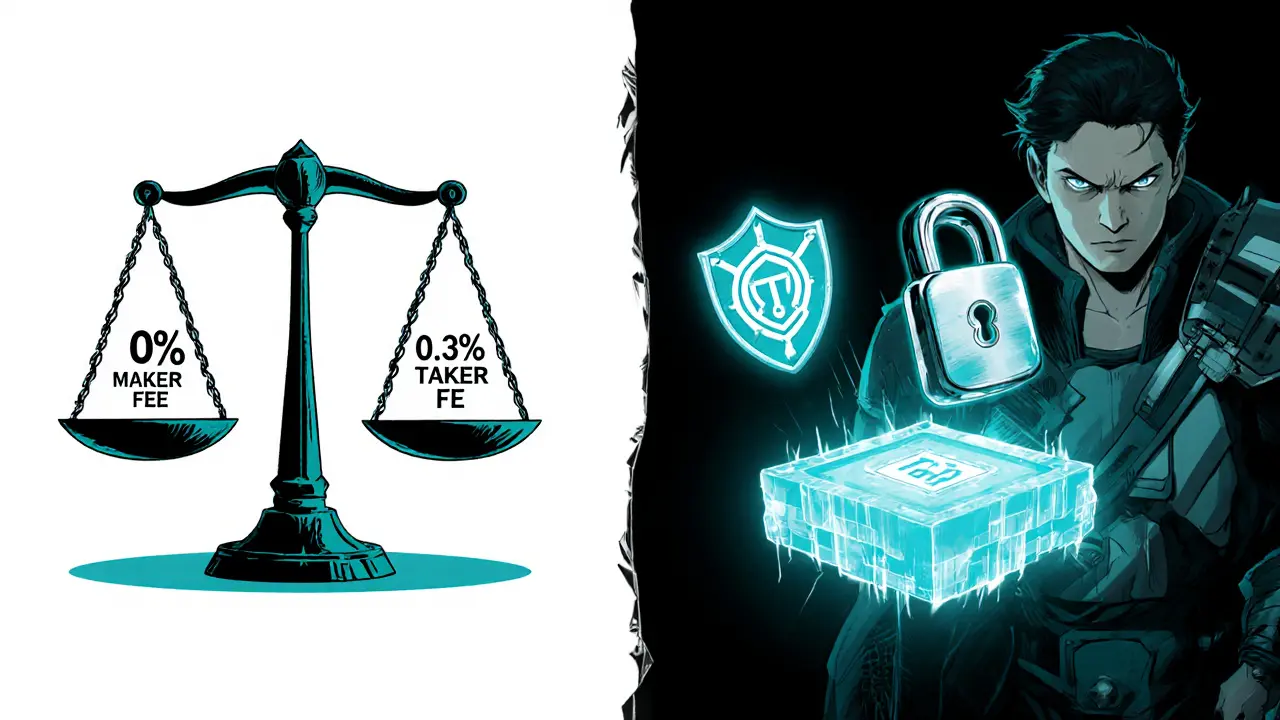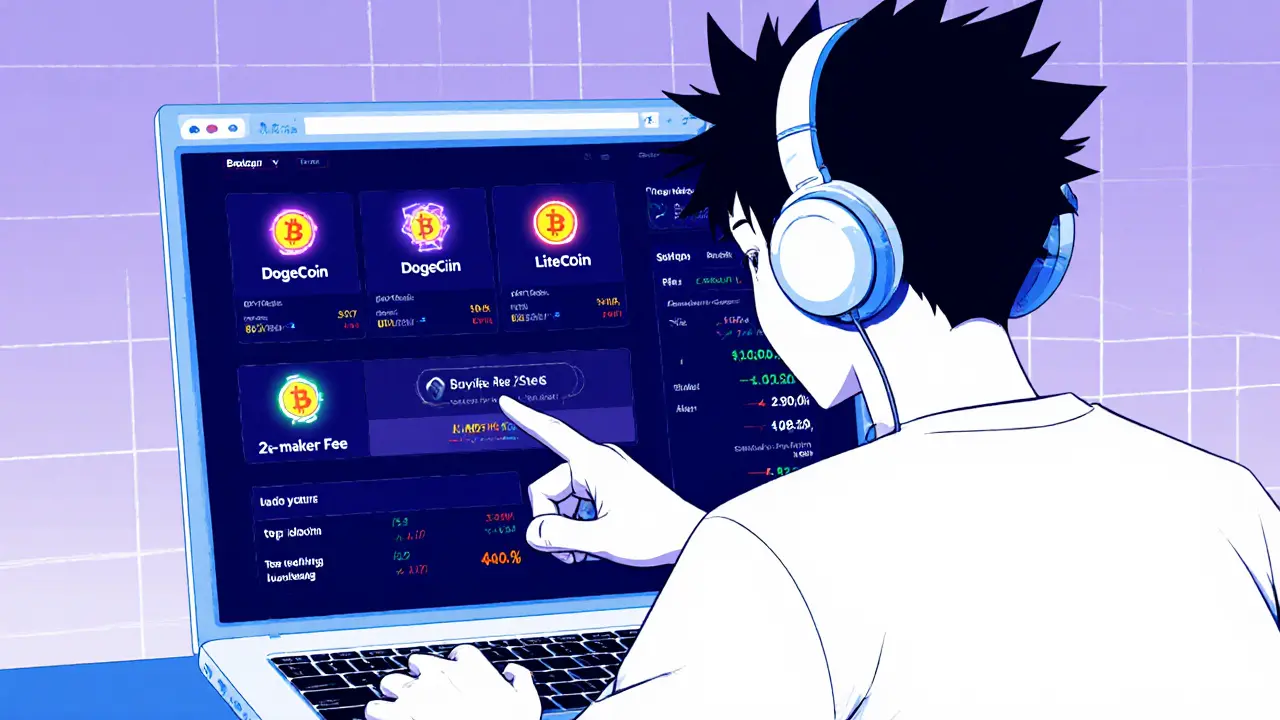Tux Exchange Fee Calculator
Compare Trading Costs
Estimate how much you'd pay in fees on Tux Exchange versus larger exchanges like Binance and Coinbase.
Fee Comparison Overview
- Tux Exchange 0% maker / 0.3% taker
- Binance 0% - 0.1% maker / 0.1% - 0.2% taker
- Coinbase 0% - 0.5% maker / 0.3% - 0.5% taker
Estimated Trading Cost
Enter values and click Calculate to see estimated fees.
When you type “Tux Exchange review” into Google, you’re probably trying to decide whether the platform was worth your time or money. Tux Exchange was a Canadian cryptocurrency exchange that operated from about 2016 until its sudden shutdown in July 2019. It focused solely on spot trading, offered zero maker fees, and charged a flat 0.3% taker fee.
What the Platform Offered
The service was built around a very simple premise: let traders buy and sell digital assets without the extra bells and whistles that larger exchanges push. There was no margin trading, futures, or complex order types-just pure spot trading. If you wanted to trade Bitcoin (BTC), Dogecoin (DOGE) or Litecoin (LTC), you could do it with a clean UI that many users described as “no‑frills but functional.”
Fee Structure - The Real Hook
Fees are the first thing every trader looks at. Tux’s most marketable number was its zero percent maker fee. In practice that meant if you placed a limit order that added liquidity to the order book, you paid nothing. The taker side - when you took liquidity away - cost a flat 0.3%, which sat a little above the industry average of roughly 0.25% at the time. For high‑volume market makers the savings were noticeable, but for casual traders the difference was marginal.
Withdrawals also carried a modest fee: 0.0007BTC per withdrawal, which was lower than most competitors. However, the platform only accepted crypto deposits - no fiat on‑ramps were offered. That rule priced out newcomers who didn’t already own Bitcoin or another supported coin.
Supported Cryptocurrencies
At its peak, Tux listed about 16‑17 coins. The lineup covered the big three - Bitcoin, Dogecoin and Litecoin - plus a handful of popular altcoins like Ethereum, Ripple and Bitcoin Cash. The limited selection was a double‑edged sword: it made the UI easier to navigate, but it also turned away traders who wanted exposure to newer projects or a broader alt‑coin market.

Security & Trust Signals
Security claims were fairly standard for the era. Tux said it stored the majority of user funds in cold storage and required two‑factor authentication (2FA) for account access. The platform never published an independent audit, and users could not verify the cold‑wallet addresses themselves. This lack of transparent proof kept the overall trust score low on community rating sites.
User Experience - The Good, the Bad, and the Ugly
On the bright side, the interface was praised for being clean and intuitive. Newcomers who managed to get crypto onto the platform liked the simple order entry screens and the fact that there were no confusing margin widgets. On the downside, the crypto‑only deposit rule created a steep entry barrier. Many users reported that they had to first buy Bitcoin on a fiat‑friendly exchange, transfer it to Tux, and then start trading - a workflow that feels unnecessary today.
Regulatory Pressure and the Sudden Shutdown
July62019 saw Tux post a brief notice blaming “unfavourable regulatory conditions” for its closure. In Canada, provincial securities regulators were tightening rules around registration, custody, and transparency for crypto platforms. Smaller exchanges like Tux faced an expensive compliance upgrade that many simply couldn’t afford. The abrupt stop meant users lost access to their accounts, transaction histories, and any remaining balances. No recovery mechanism was offered, making the incident a cautionary tale about the fragility of centralized exchanges without robust legal backing.

How Tux Stacked Up Against Bigger Players
| Feature | Tux Exchange | Binance | Coinbase |
|---|---|---|---|
| Supported assets | ~16 | >200 | ~50 |
| Maker fee | 0% (free) | 0% - 0.1% | 0% - 0.5% |
| Taker fee | 0.30% | 0.10% - 0.20% | 0.30% - 0.50% |
| Deposit methods | Crypto‑only | Crypto & fiat (bank, card) | Crypto & fiat (bank, card) |
| Security proofs | Cold storage claim, no audit | Third‑party audit, insurance fund | Third‑party audit, FDIC insurance (USD) |
| Regulatory status (Canada) | Closed 2019 | Operating, compliant | Operating, compliant |
In short, Tux’s fee advantage was real but narrow. Bigger platforms offered a vastly larger asset universe, fiat on‑ramps, and audited security - factors that outweighed the modest cost difference for most traders.
Lessons for Traders and New Exchanges
- Fee structure alone isn’t enough. Zero maker fees attracted some market makers, but without a solid asset lineup and fiat options, the appeal stayed limited.
- Transparency matters. Independent security audits and clear custody policies build trust. Tux’s vague claims left users uneasy.
- Regulatory readiness is critical. The Canadian crackdown in 2018‑2019 showed that compliance costs can sink a small exchange overnight.
- Exit plans are essential. Users should always keep backups of transaction histories and avoid storing large balances on a single platform.
Bottom Line
If you were a high‑volume market maker who only needed a handful of major coins, Tux’s zero‑maker‑fee model could have saved you a few dollars per month. For anyone else - beginners, alt‑coin hunters, or traders wanting advanced order types - the platform’s shortcomings outweighed its cost benefits. The abrupt shutdown also proves that a low‑fee promise is meaningless if the exchange can’t survive regulatory pressure.
Frequently Asked Questions
Why did Tux Exchange shut down?
The company cited "unfavourable regulatory conditions" in Canada. New compliance rules required costly upgrades that the small exchange could not afford, leading to a full service termination on July62019.
Could I still retrieve funds from Tux?
No. The platform stopped all withdrawals and account access at the time of closure. Users who left assets on the exchange effectively lost them.
How did Tux’s fees compare to Binance and Coinbase?
Tux offered a 0% maker fee and a 0.30% taker fee. Binance’s taker fee ranged from 0.10% to 0.20% with a similar maker‑fee tier, while Coinbase’s taker fee was 0.30% to 0.50% and also charged maker fees for many pairs. So Tux was cheaper for pure makers but otherwise on par or slightly higher for takers.
What security measures did Tux provide?
The exchange claimed cold‑storage of the bulk of funds and required 2FA for login. However, it never published third‑party audit reports, so users could not independently verify those claims.
Is there any chance Tux Exchange will return?
All domain and server infrastructure have been shut down since 2019, and the founders have not announced any revival plans. It’s highly unlikely the platform will ever come back.







Shaian Rawlins
June 21, 2025 AT 17:00When I first heard about Tux Exchange I thought it might be a neat little niche platform for low‑fee traders. The idea of zero‑maker fees certainly caught my eye, especially because most big exchanges charge something even for makers. I dug into the fee table and noticed that the taker fee of 0.30% was actually a bit higher than Binance’s typical 0.10‑0.20% range. That trade‑off makes sense if you’re only providing liquidity, but most retail folks end up being takers more often than not. The review also points out that Tux only supported a handful of major coins, which limits its appeal for anyone looking to diversify. I also saw the lack of fiat on‑ramps, something that really matters if you’re trying to move money in and out of crypto without using another exchange. The regulatory pressure in Canada that forced the shutdown is a reminder that compliance costs can sink smaller players fast. I think the lesson here is that low fees alone can’t compensate for missing features and a solid compliance backbone. For market makers who only need BTC and ETH, the cost savings might have been real, but they’d still need to juggle another platform for everything else. The article’s comparison table made it clear that even though the maker fee was zero, the overall cost picture wasn’t dramatically better for most traders. It also highlighted that Tux never published an independent audit, which left many users uneasy about security. With crypto assets, trust is as important as price, and a missing audit can be a red flag. The shutdown left users with no way to withdraw funds, which is a worst‑case scenario nobody wants to face. In hindsight, the platform’s narrow focus and lack of transparency probably made it vulnerable from day one. If you’re looking at new exchanges, it’s worth asking: do they have a clear regulatory strategy and solid security proof? Those factors usually outweigh a few basis points in fee savings. All in all, Tux was an interesting experiment, but the market has moved on to larger, more compliant services that balance cost and safety.
Miranda Co
June 24, 2025 AT 14:27Zero‑maker fees sounded like a gold rush, but the taker fee was still 0.30%, which isn’t a real bargain. Plus, they only had a few coins, so you’re stuck trading the same stuff. No audit? That’s just reckless, especially when you’re handling other people’s money.
Promise Usoh
June 27, 2025 AT 11:54In the context of regulatory compliance, the Canadian authorities imposed standards that small enterprises often struggle to meet. Tux Exchange’s inability to secure adequate capitol for necessary upgrades ultimately precipitated its closure. The absence of a third‑party audit further eroded stakeholder confidence, thereby accelerating the demise of the platform.
Rob Watts
June 30, 2025 AT 09:20Sounds cheap but risky.
Bhagwat Sen
July 3, 2025 AT 06:47Yo, anyone still remembers the hype around Tux? I was all in because the fees were “free” for makers – thought it’d be a game changer. Turns out the platform vanished overnight, took everyone’s crypto with it.
Cathy Ruff
July 6, 2025 AT 04:14Zero maker fees? More like zero safety. They bragged about low cost but offered no audit no fiat no support. Guess they learned the hard way that cheap doesn’t equal trustworthy.
mukesh chy
July 9, 2025 AT 01:40Oh great, another “revolutionary” exchange that promises free trades. Then a year later it disappears and leaves you holding the bag. Who needs regulation anyway, right?
Eva Lee
July 11, 2025 AT 23:07From a liquidity provisioning perspective, Tux’s 0% maker tier was theoretically optimal for arbitrageurs, yet the platform’s limited asset spectrum and lack of on‑ramp KYC/AML frameworks rendered it suboptimal for institutional order flow integration.
stephanie lauman
July 14, 2025 AT 20:34It is evident that the abrupt cessation of Tux Exchange was not merely a regulatory casualty but a deliberate move orchestrated by shadow banking entities to eliminate competition that threatened their fee structures. The silence surrounding the audit disclosures raises suspicion of deeper financial manipulation. One must remain vigilant, as such covert operations are commonplace in the crypto arena :) .
Patrick MANCLIÈRE
July 17, 2025 AT 18:00For anyone diving into this space, it’s worth noting that an exchange’s longevity often hinges on its ability to adapt to local law. Tux missed that mark in Canada, which is why it folded. Always keep a diversified set of wallets to avoid total loss.
Ciaran Byrne
July 20, 2025 AT 15:27Low fees aren’t everything; security and compliance matter more.
Greer Pitts
July 23, 2025 AT 12:54i swear i left some btc on tux and now its gone lol guess i should've used a hardware wallet.
Lurline Wiese
July 26, 2025 AT 10:20Can you believe I actually trusted Tux with my savings? It felt like a dream until the lights went out and poof – my crypto vanished. Total nightmare!
Adarsh Menon
July 29, 2025 AT 07:47Free maker fees? Yeah right. They probably gave it away to get users then pulled the plug.
Jim Griffiths
August 1, 2025 AT 05:14Key takeaway: always check for third‑party audits and fiat support before committing funds.
Tyrone Tubero
August 4, 2025 AT 02:40In the annals of crypto history, Tux Exchange will be remembered as a fleeting comet – brilliant for a moment, then consumed by the darkness of regulatory fire.
Taylor Gibbs
August 7, 2025 AT 00:07When evaluating exchanges, think about the community support and the resources they provide for newcomers. Tux lacked educational material, making it harder for beginners to navigate safely.
Amy Harrison
August 9, 2025 AT 21:34💡 If you’re hunting for low‑fee platforms, keep an eye on the ones that balance cost with solid security! 😎 It’s better to pay a tiny bit more and sleep easy at night.
Marc Addington
August 12, 2025 AT 19:00These foreign crypto scams just want to bleed American investors dry. If you’re not using a US‑regulated exchange, you’re asking for trouble.
Amal Al.
August 15, 2025 AT 16:27It’s truly disheartening to see another exchange collapse; however, this should serve as a powerful reminder to all of us to maintain diversified storage solutions, regularly back up transaction records, and remain ever‑vigilant regarding regulatory developments. By doing so, we can collectively safeguard our assets against such unforeseen failures.
Scott McReynolds
August 18, 2025 AT 13:54Looking back at the Tux saga, it’s clear that the crypto ecosystem is still in its adolescence, learning the hard way which practices are sustainable. The allure of zero‑maker fees can be intoxicating for high‑frequency traders, yet the broader marketplace demands more than just cheap trades. Security audits, transparent governance, and fiat accessibility are pillars that any exchange must erect to earn long‑term trust. When Tux sidestepped these fundamentals, it planted the seeds of its own demise. The Canadian regulatory crackdown, while harsh, was a predictable outcome for a platform that operated without robust compliance frameworks. For newcomers, the lesson is priceless: never chase the cheapest price without verifying the underlying safety nets. Diversify not only your assets but also the platforms you use, and keep the majority of your holdings in hardware wallets you control. In doing so, you mitigate the risk of a sudden shutdown leaving you stranded. Moreover, staying informed about regional regulatory trends can give you a heads‑up before a platform becomes non‑viable. The crypto world is evolving, and with each new exchange, there’s an opportunity to set higher standards. Let’s hope future projects learn from Tux’s missteps and build more resilient, user‑centric ecosystems. In the end, a balanced approach to cost, security, and compliance will always outweigh the fleeting thrill of zero‑fee promises. Remember, the market rewards patience over the pursuit of instantaneous gains. Keep your eyes open and your keys safe.
Katherine Sparks
August 21, 2025 AT 11:20I understand your concerns regarding the lack of an audit and the limited coin selection; it can indeed be unsettling for investors seeking assurance. While zero‑maker fees are appealing, the broader security framework should never be overlooked. If you ever need guidance on diversifying your portfolio securely, feel free to reach out – I’m happy to help. 😊